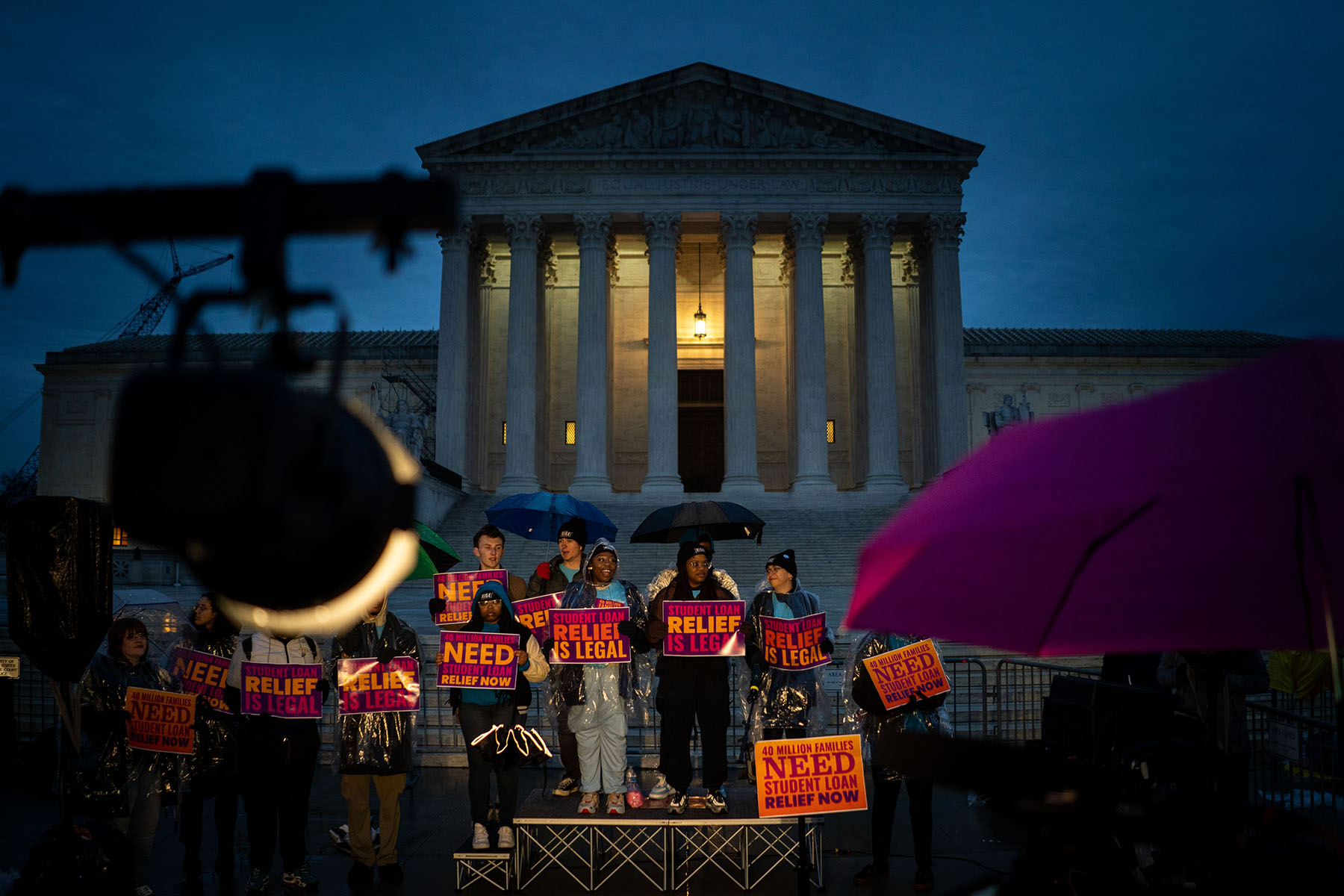Editor’s note: This article has been updated throughout.
Your trusted source for contextualizing the news. Sign up for our daily newsletter.
Now that the Supreme Court has blocked President Joe Biden’s student loan relief plan, 40 million borrowers — a disproportionate number of them women, people of color and low-income individuals — must prepare to repay the debt they had hoped would be forgiven.
On Friday, the court decided unanimously in U.S. Department of Education v. Brown that the plaintiffs, two borrowers who sought to block student loan forgiveness because they did not qualify for any or all of the loan relief the Biden administration offered, had no legal standing to sue. However, the court ruled against the president in Biden v. Nebraska, in which six Republican-led states argued that canceling loan debt would have an adverse financial impact on student loan servicers in their jurisdictions. In both cases, the plaintiffs argued that the president did not have the authority to implement loan forgiveness.
Chief Justice John Roberts wrote for the conservative majority, with Justices Elena Kagan, Sonia Sotomayor and Ketanji Brown Jackson dissenting.
In August, the White House announced a plan to forgive up to $20,000 in student debt for borrowers with annual incomes under $125,000. Opponents of the plan filed lawsuits shortly afterward, blocking the president’s ability to offer relief as federal and private education debt topped an estimated $1.7 trillion.
Lawyers for the plaintiffs in the two cases that reached the court argued that the Biden administration needed approval from Congress to broadly forgive $400 billion in student debt. The Biden administration said that it had the right to cancel the debt because the Higher Education Relief Opportunities for Students (HEROES) Act of 2003 allows the education secretary to “waive or modify any statutory or regulatory provision” during national emergencies, which include crises such as the COVID-19 pandemic.
To win the case, the plaintiffs had to do more than question whether the Biden administration could eliminate hundreds of billions of student debt. Since Article III of the Constitution specifies that people suing in federal court illustrate that a government policy has harmed them directly, they also had to demonstrate that they had legal standing to sue. The states managed to do that.
The Biden defeat is a blow to borrowers and debt relief advocates.
Before the decision, debt cancellation advocates circulated a petition demanding that Justice Samuel Alito recuse himself from the case after investigative reporting linked him to a hedge fund manager and financial backer of one of the debt relief lawsuits. Alito voted against the forgiveness plan.
As Republicans in Congress have tried to block debt forgiveness, Democrats have staunchly defended the relief plan. Among them is Sen. Elizabeth Warren, who said on Twitter after the Supreme Court’s decision, “The same Supreme Court that overturned Roe now refuses to follow the plain language of the law on student loan cancellation. This fight is not over. The president has more tools to cancel student debt — and he must use them.”
Warren had championed the Biden administration’s loan forgiveness plan because it would have eliminated the student debt of about a quarter of Black borrowers and half of Latino borrowers, she said during a virtual discussion hosted Monday by the Student Borrower Protection Center about how debt relief intersects with racial and gender justice.
Rep. Ayanna Pressley, who has also advocated for student loan forgiveness, said in a statement that she vehemently disagrees with the Supreme Court’s decision. “The court put monied interests above the law and the will of the people today,” Pressley said. “The president’s plan to cancel student debt would change and save lives, and borrowers across the country who feel devastated by this unjust ruling should know that this fight is not over.”
Warren called the student loan system “broken” during Monday’s a virtual discussion. It is “rigged against women, and women of color in particular are bearing the brunt of this crisis,” she said. “Women hold two-thirds of all student loan debt in this country, and Black women are more likely to hold debt and have the highest debt totals overall, compared with any other group.”
A USA TODAY/Ipsos poll of 1,029 American adults released in May found that 47 percent of Americans support Biden’s forgiveness plan, 41 percent oppose it and 12 percent are undecided, while 35 percent are in favor of a Supreme Court block of the president’s relief program. Among borrowers, support differs, with 83 percent of these respondents backing the plan and 50 percent saying “it doesn’t go far enough.” Although conservatives — including 22 Republican governors who cosigned a letter demanding that Biden rescind his loan relief plan — have argued that forgiveness is unfair to people without student debt, about three in four USA TODAY/Ipsos poll participants who support relief don’t have education loans themselves.
Race also influenced survey results, with more than half of Black and Hispanic respondents backing loan forgiveness compared with about two in five White respondents. Black students are overrepresented among the group of borrowers who have loan debt without a college degree to show for it.
State and local governments and academic institutions are taking steps to make college more affordable as enrollment has dropped in recent years, particularly during the pandemic. Wellesley College has eliminated packaged loans for students with under $100,000 of parental income to keep student debt levels low. Through its PayDirt Promise, the University of Texas at El Paso covers full tuition and mandatory fees for four years for families with incomes under $75,000. And Boston University (BU) offers expanded financial aid packages to cover the difference between tuition costs and what students can afford. The school’s affordableBU program allows it to meet 100 percent of its first-year students’ demonstrated financial need.
“For students that are eligible or receiving a federal Pell Grant, they actually get their full needs met without a loan expected in the package,” said Christine McGuire, BU’s vice president and associate provost for enrollment and student administration. “So that’s even better. Students that aren’t Pell eligible get their full needs met, but there might be a federally guaranteed loan in the package. The other interesting thing about our affordableBU is that the grant money that you’re awarded that first year is guaranteed for your four years that you’re here.”
McGuire said that BU leaders want to reduce the debt that families have traditionally taken on to pay for a college education. Over the five years that the institution has expanded its financial program to make this happen, BU has seen students and parents cut their borrowing in half.
The university also meets the full financial need of admitted students who graduated from Boston Public Schools. While reducing student and parent debt is one BU goal, it isn’t the only reason for the school’s new approach to financial aid.
“Our vision was much broader than just reducing debt,” McGuire said. “Our president, Robert Brown, and the provost, Jean Morrison, were both very concerned about the socioeconomic diversity of our undergraduates. So this concern is part of the university’s strategic vision to become a more diverse and inclusive institution. You need to have all sorts of lived experiences in the classroom in order to contribute to the quality of the dialogue in the educational experience.”
In May, the Minnesota legislature passed a bill that would waive college tuition for students with family incomes under $80,000. About half the states have similar programs, and dozens of municipalities offer free tuition to their K-12 graduates who enroll in local community colleges and, from there, in local public universities. During his presidential campaign, Biden said he planned to make community college free, a proposition that voters across partisan lines support.
Gloria Blackwell, CEO of the American Association of University Women, which advocates for gender equity through education, said during this week’s webinar with Warren that she knows firsthand what it’s like to graduate with student debt. She was a first-generation college grad.
“When we graduate, loan payments collide with lower salaries due to the unrelenting gender pay gap, and, even before the pandemic, women who graduated with a bachelor’s degree only earned about 81 percent of what our male peers earned,” Blackwell said. “So none of this sounds equitable, I am sure, to any of us. So, our country needs student debt relief because the economic security of millions of us women and their families is on the line. With the gender pay gap, the racial pay gap, not to mention the motherhood penalty, collide, it’s enough to jeopardize women’s economic security for a generation.”
As state and local governments, lawmakers and colleges themselves try to reduce higher education costs, polls have found that many Americans no longer have confidence in a college degree’s value. A CNBC + Acorns Invest In You Student Loan Survey of 5,162 adults conducted online over three days in January 2022 found that 54 percent of federal student loan borrowers said the debt they accrued was not worth it, while 44 percent of respondents said it was. Men are more likely than women to question the value of a college degree, according to a survey of 1,019 people conducted from March 1 through March 13 by the National Opinion Research Center (NORC), a nonpartisan think tank at the University of Chicago. But women are also questioning if college is worth it, with 44 percent of them having confidence in higher education, a drop of 10 percent since 2017, according to the NORC poll.
Now that the Supreme Court has weighed in on the Biden relief program, federal student loan payments, which have been paused repeatedly during the pandemic, are scheduled to resume in the fall.
“Having the federal student loan repayment put on hold during the pandemic was a lifeline for Black and Brown women and their families,” Blackwell said. She noted that women filed most unemployment claims during the pandemic’s first year despite being only half of the labor force. Since student debt relief, paid leave and fair wages are intertwined, her organization is also pushing for Congress to pass the Paycheck Fairness Act and the Family and Medical Insurance Leave Act to close the gender pay gap and ensure women receive paid time off for illness, family care, or paid parental leave, she said.
“Student debt relief is not merely an economic issue,” Blackwell said. “It is an issue of gender and racial justice. We do truly believe this is a watershed moment to determine our future and that, working together, all of us can provide the equity that all women in our society as a whole deserve.”







